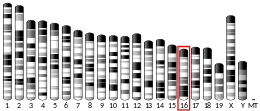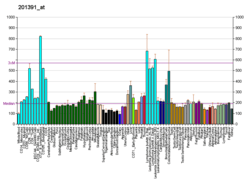TRAP1
Heat shock protein 75 kDa, mitochondrial is a protein that in humans is encoded by the TRAP1 gene.[5][6][7]
References
- GRCh38: Ensembl release 89: ENSG00000126602 - Ensembl, May 2017
- GRCm38: Ensembl release 89: ENSMUSG00000005981 - Ensembl, May 2017
- "Human PubMed Reference:". National Center for Biotechnology Information, U.S. National Library of Medicine.
- "Mouse PubMed Reference:". National Center for Biotechnology Information, U.S. National Library of Medicine.
- Felts SJ, Owen BA, Nguyen P, Trepel J, Donner DB, Toft DO (March 2000). "The hsp90-related protein TRAP1 is a mitochondrial protein with distinct functional properties". J Biol Chem. 275 (5): 3305–12. doi:10.1074/jbc.275.5.3305. PMID 10652318.
- Song HY, Dunbar JD, Zhang YX, Guo D, Donner DB (March 1995). "Identification of a protein with homology to hsp90 that binds the type 1 tumor necrosis factor receptor". J Biol Chem. 270 (8): 3574–81. doi:10.1074/jbc.270.8.3574. PMID 7876093.
- "Entrez Gene: TRAP1 TNF receptor-associated protein 1".
- Simmons, A D; Musy M M; Lopes C S; Hwang L Y; Yang Y P; Lovett M (November 1999). "A direct interaction between EXT proteins and glycosyltransferases is defective in hereditary multiple exostoses". Hum. Mol. Genet. 8 (12): 2155–64. doi:10.1093/hmg/8.12.2155. ISSN 0964-6906. PMID 10545594.
- Chen, C F; Chen Y; Dai K; Chen P L; Riley D J; Lee W H (September 1996). "A new member of the hsp90 family of molecular chaperones interacts with the retinoblastoma protein during mitosis and after heat shock". Mol. Cell. Biol. 16 (9): 4691–9. doi:10.1128/MCB.16.9.4691. ISSN 0270-7306. PMC 231469. PMID 8756626.
Further reading
- Maruyama K, Sugano S (1994). "Oligo-capping: a simple method to replace the cap structure of eukaryotic mRNAs with oligoribonucleotides". Gene. 138 (1–2): 171–4. doi:10.1016/0378-1119(94)90802-8. PMID 8125298.
- Chen CF, Chen Y, Dai K, et al. (1996). "A new member of the hsp90 family of molecular chaperones interacts with the retinoblastoma protein during mitosis and after heat shock". Mol. Cell. Biol. 16 (9): 4691–9. doi:10.1128/MCB.16.9.4691. PMC 231469. PMID 8756626.
- Suzuki Y, Yoshitomo-Nakagawa K, Maruyama K, et al. (1997). "Construction and characterization of a full length-enriched and a 5'-end-enriched cDNA library". Gene. 200 (1–2): 149–56. doi:10.1016/S0378-1119(97)00411-3. PMID 9373149.
- Charng MJ, Zhang D, Kinnunen P, Schneider MD (1998). "A novel protein distinguishes between quiescent and activated forms of the type I transforming growth factor beta receptor". J. Biol. Chem. 273 (16): 9365–8. doi:10.1074/jbc.273.16.9365. PMID 9545258.
- Simmons AD, Musy MM, Lopes CS, et al. (1999). "A direct interaction between EXT proteins and glycosyltransferases is defective in hereditary multiple exostoses". Hum. Mol. Genet. 8 (12): 2155–64. doi:10.1093/hmg/8.12.2155. PMID 10545594.
- Wurthner JU, Frank DB, Felici A, et al. (2001). "Transforming growth factor-beta receptor-associated protein 1 is a Smad4 chaperone". J. Biol. Chem. 276 (22): 19495–502. doi:10.1074/jbc.M006473200. PMID 11278302.
- Strausberg RL, Feingold EA, Grouse LH, et al. (2003). "Generation and initial analysis of more than 15,000 full-length human and mouse cDNA sequences". Proc. Natl. Acad. Sci. U.S.A. 99 (26): 16899–903. Bibcode:2002PNAS...9916899M. doi:10.1073/pnas.242603899. PMC 139241. PMID 12477932.
- Ota T, Suzuki Y, Nishikawa T, et al. (2004). "Complete sequencing and characterization of 21,243 full-length human cDNAs". Nat. Genet. 36 (1): 40–5. doi:10.1038/ng1285. PMID 14702039.
- Masuda Y, Shima G, Aiuchi T, et al. (2004). "Involvement of tumor necrosis factor receptor-associated protein 1 (TRAP1) in apoptosis induced by beta-hydroxyisovalerylshikonin". J. Biol. Chem. 279 (41): 42503–15. doi:10.1074/jbc.M404256200. PMID 15292218.
- Gerhard DS, Wagner L, Feingold EA, et al. (2004). "The Status, Quality, and Expansion of the NIH Full-Length cDNA Project: The Mammalian Gene Collection (MGC)". Genome Res. 14 (10B): 2121–7. doi:10.1101/gr.2596504. PMC 528928. PMID 15489334.
- Brown V, Brown RA, Ozinsky A, et al. (2006). "Binding specificity of Toll-like receptor cytoplasmic domains". Eur. J. Immunol. 36 (3): 742–53. doi:10.1002/eji.200535158. PMC 2762736. PMID 16482509.
- Im CN, Lee JS, Zheng Y, Seo JS (2007). "Iron chelation study in a normal human hepatocyte cell line suggests that tumor necrosis factor receptor-associated protein 1 (TRAP1) regulates production of reactive oxygen species". J. Cell. Biochem. 100 (2): 474–86. doi:10.1002/jcb.21064. PMID 16927372.
External links
- TRAP1 human gene location in the UCSC Genome Browser.
- TRAP1 human gene details in the UCSC Genome Browser.
This article is issued from Wikipedia. The text is licensed under Creative Commons - Attribution - Sharealike. Additional terms may apply for the media files.




